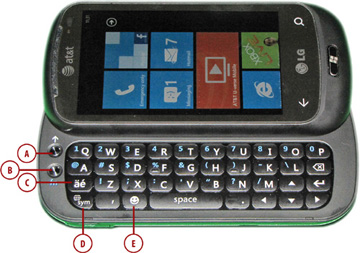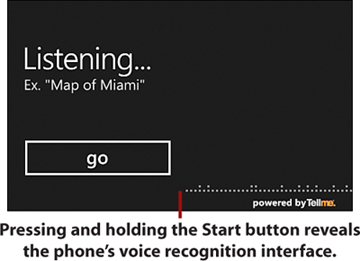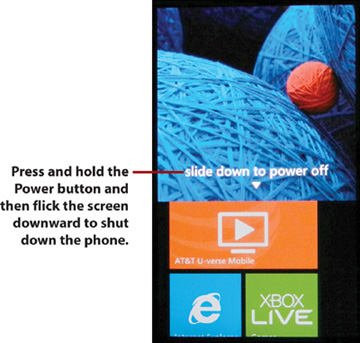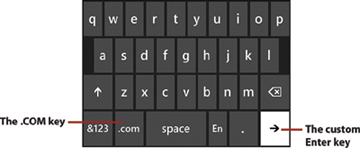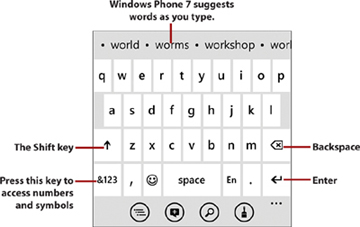The New Interface
The Windows Phone operating system was designed completely from scratch, and as such the user interface is nothing like Microsoft has ever created before. The new interface is designed so that you can interact with virtually all aspects of the operating system using a touch screen.
The Lock Screen
When you turn on a Windows Phone device, the first thing you see is the Lock screen. Although this screen initially looks like nothing more than a wallpaper screen, it provides several pieces of information.
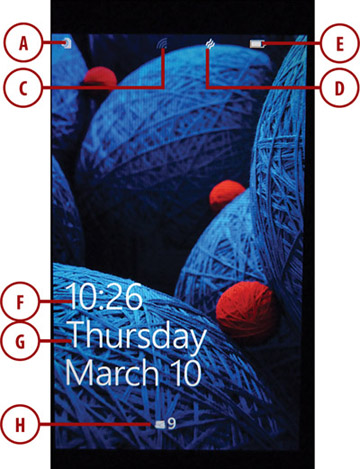
- Cellular signal strength—This indicator displays the signal strength as a series of bars. It also shows you when no cellular service is available.
- Wireless Connection type—This is an icon that displays the type of wireless connection. For example, the icon could indicate 3G connectivity.
- Wi-Fi indicator—This icon shows you whether or not Wi-Fi is enabled.
- Bluetooth indicator—This is an icon which indicates whether or not Bluetooth is enabled.
- Battery Strength—The battery indicator shows how much battery power remains.
- Time—The current time.
- Date—Today’s date.
- Message indicator—The bottom of the lock screen might contain icons indicating you have missed calls or that you have new email or text messages.
The Start Screen
The Start screen (which can be accessed by pressing the Start button) contains a series of tiles, which Microsoft refers to as live tiles. Live tiles serve two different purposes. First, you can access commonly used portions of the operating system by tapping the appropriate live tile. Second, live tiles are often dynamically updated to provide important information through the tile itself. For instance live tiles can tell you how many email messages you have waiting or how many calls you have missed. These are the tiles present on the Start screen by default:
- Phone—The Phone tile provides one-touch access to the dialing pad. The tile also displays the current number of missed calls.
- People—The People tile provides access to your contact list (known as the People Hub). The tile displays thumbnails of the profile photos used within your contacts.
- Messaging—The Messaging tile displays the number of unread SMS text messages. You can tap the tile to access the messaging app.
- Outlook—The Outlook tile displays the total number of unread email messages while also providing one-touch access to Outlook.
- Internet Explorer—The Internet Explorer tile provides access to Internet Explorer.
XBOX Live—The XBOX Live tile provides access to your collection of games.
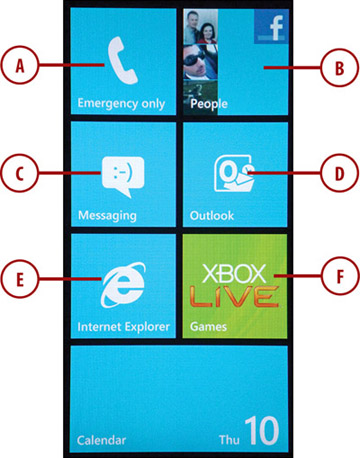
- Calendar—The Calendar tile displays your next appointment and provides one-touch access to the device’s calendar.
- Pictures—The Pictures tile provides access to your photo collection. The tile itself displays one of your photos.
- Music + Video—This tile provides access to multimedia content that is stored on the phone.
- Marketplace—The Marketplace is Microsoft’s app store. This tile can sometimes display a numerical value indicating the number of updates available for the apps you have purchased.
- Me—The Me tile dynamically displays your profile picture and links you to information about you that was downloaded from social networking sites.
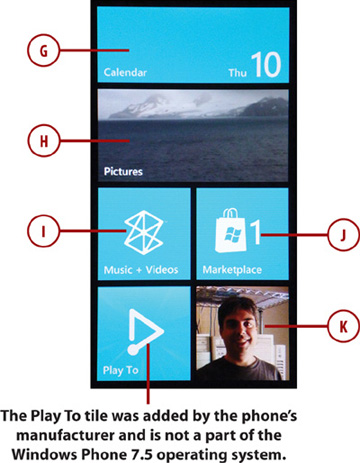
Using the Phone’s Hardware Buttons
As you saw at the beginning of the chapter, the front of the phone contains three hardware buttons. These buttons perform a variety of functions depending on whether they are pressed or held.
The Back Button
Pressing the Back button returns you to the previous screen. In some cases this can be a bit disorientating, however, because if your previous screen was the Start screen, the phone will usually skip it and take you instead to the screen that you were viewing prior to the Start screen.
If you hold down the Back button, Windows displays the Task Switcher, which is new to Windows Phone 7. The Task Switcher displays a series of recently visited screens so you can pick the screen you want to return to without having to repeatedly press the Back button.
The Start Button
Pressing the Start button from anywhere in the operating system will take you to the phone’s Start screen. Holding down on the Start button takes you to the Voice Command screen. Voice control is covered in detail in Chapter 9, “Search,” along with verbal searches.
The Search Button
Pressing the Search button takes you to a search engine. The exact type of search that is provided varies depending on what screen you were viewing when you pressed the Search button. Searches are discussed at length in Chapter 9.
The Power Button
Pressing the Power button turns off the phone’s display. You can turn the display back on by pressing the Power button again. When you turn off the display, the phone is still active. It can still receive phone calls, text messages, and so on.
If you need to completely shut down the phone, you can do so by pressing and holding the Power button. After several seconds, the phone displays a Zune style Shut-down screen that requires you to swipe the screen downward in order to shut down the phone. You can power the phone back up by pressing the Power button.
Touch Gestures
Windows Phone uses a multi-touch display that supports six distinct touch gestures. These gestures include
• Tap—In the Windows Phone OS, a tap works exactly like it did in previous versions of Windows Mobile. You simply tap your finger on an object to select it.
• Double-tap—Windows Phone allows you to open files and applications by double-tapping them.
• Pan—Panning allows you to scroll the device’s screen. You simply press your finger onto the device screen and then move your finger in the direction that you want to pan. The main Windows Phone screen contains too many tiles to fit all of them onto the screen at once, so you must pan the screen to access some of the tiles.
• Flick—Flicking allows you to scroll rapidly through a long list of items. Flicking is similar to panning except that once you have pressed your finger onto the screen, you slide it quickly and then remove your finger.
• Touch and Hold—The touch and hold gesture is used similarly to right-clicking your mouse in Windows 7. You simply press an object on the screen and then hold your finger in the same position until any available options are displayed. For example, you can use the touch and hold gesture to pin an item to the Start screen.
• Stretch—Stretching is a gesture that you can use to make an object on the screen bigger. For example, you might use the stretch gesture to zoom in on a picture, or you could use the stretch gesture to zoom in on an area within your Web browser. You can stretch an area by placing two fingers onto the screen and then sliding those fingers apart.
• Pinch—Pinching is the opposite of stretching. It is used as a way to zoom out. To pinch, spread two fingers apart and then put them on the screen and slide your fingers until they come together.
The Soft Keyboard
The primary method of entering text into Windows Phone is through a soft (on screen) keyboard. Rather than providing you with a generic soft keyboard, Windows Phone uses one of seven different soft keyboards depending on the activity being performed. These soft keyboards include:
Default—A standard QWERTY keyboard layout.
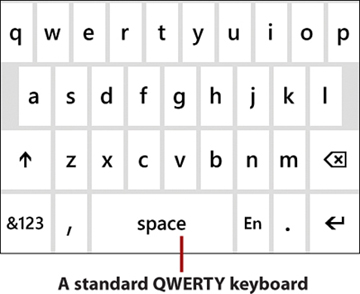
Text—A standard QWERTY layout, plus emoticons.
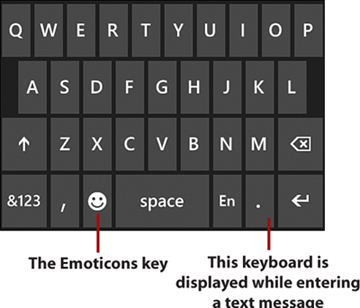
Email Address—QWERTY layout plus a .com and an @ key.
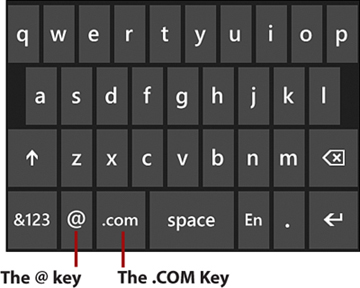
Phone Number—A twelve key phone layout.
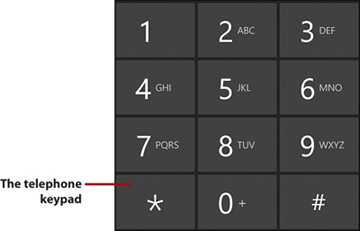
Web Address—QWERTY layout plus a .com key and a custom Enter key.
Search and Maps—QWERTY layout plus a custom Enter key.
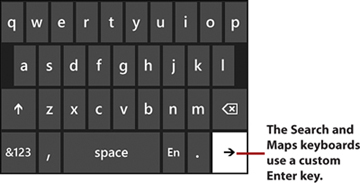
- SMS Address—QWERTY layout with access to the phone layout.
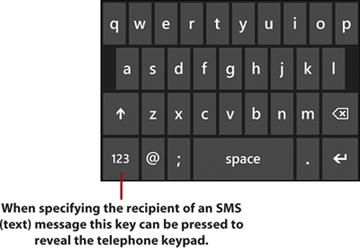
Typing with the soft keyboard can take a little bit of getting used to. The soft keyboard lacks the tactical feel of a hardware keyboard, and the screen’s size limits the size of the keys. As such, typing can be a little bit tricky. Fortunately, there are a few things you can do to make typing easier.
One suggestion is to turn the phone sideways. When you do, the display changes to a landscape orientation. This causes the keys on the soft keyboard to become wider, which makes typing easier.
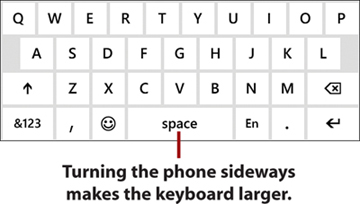
As you type, Windows suggests words based on the letters you have entered. You can tap on a suggested word rather than having to type the entire word.
The soft keyboard does not contain a caps lock key. To activate Caps Lock, simply tap and hold the shift key for a few seconds. Repeat the process to release Caps Lock.
The Hardware Keyboard
Some Windows Phone devices include a hardware keyboard that slides out from beneath the screen. Hardware keyboards typically include a few specialized keys including
- Shift—The Shift key is displayed as an up arrow and toggles between uppercase and lowercase text.
- Function—The function key is usually displayed as FN and switches between letters and the number or symbols displayed in blue.
- AE—Displays an onscreen keyboard containing foreign variations of the character that was most recently typed.
- Symbols—On some phones the Symbol (SYM) key does the same thing as the function (FN) key.
- Emoticons—Displays an onscreen keyboard containing a series of emoticons.
